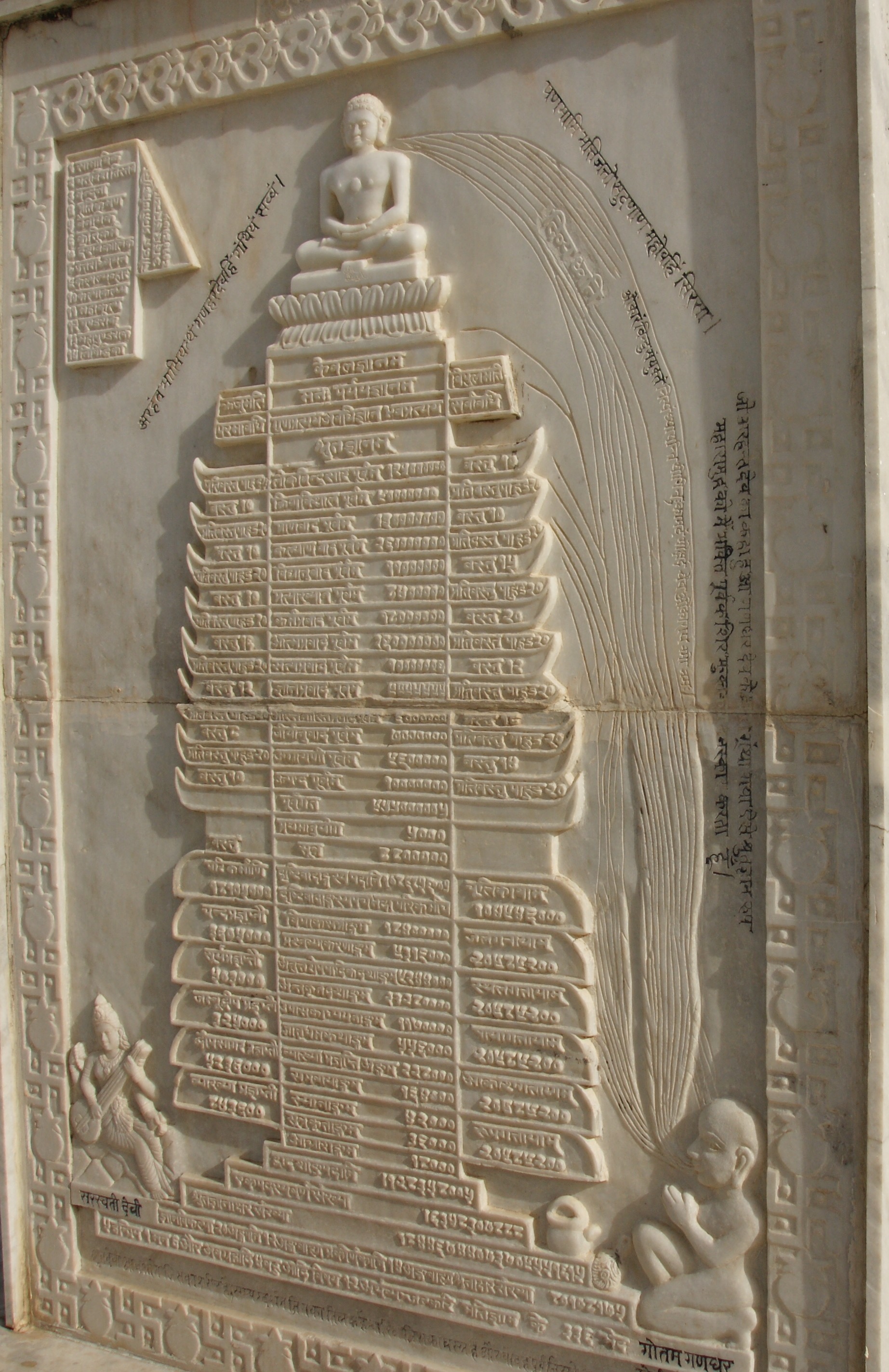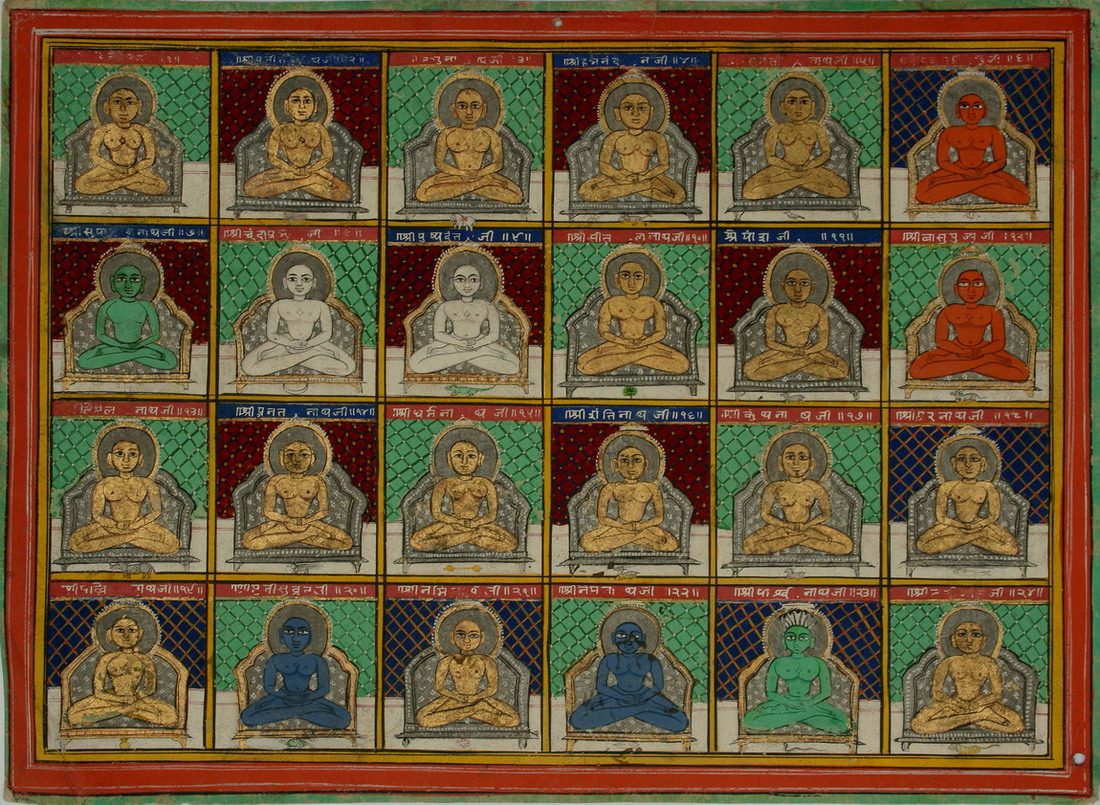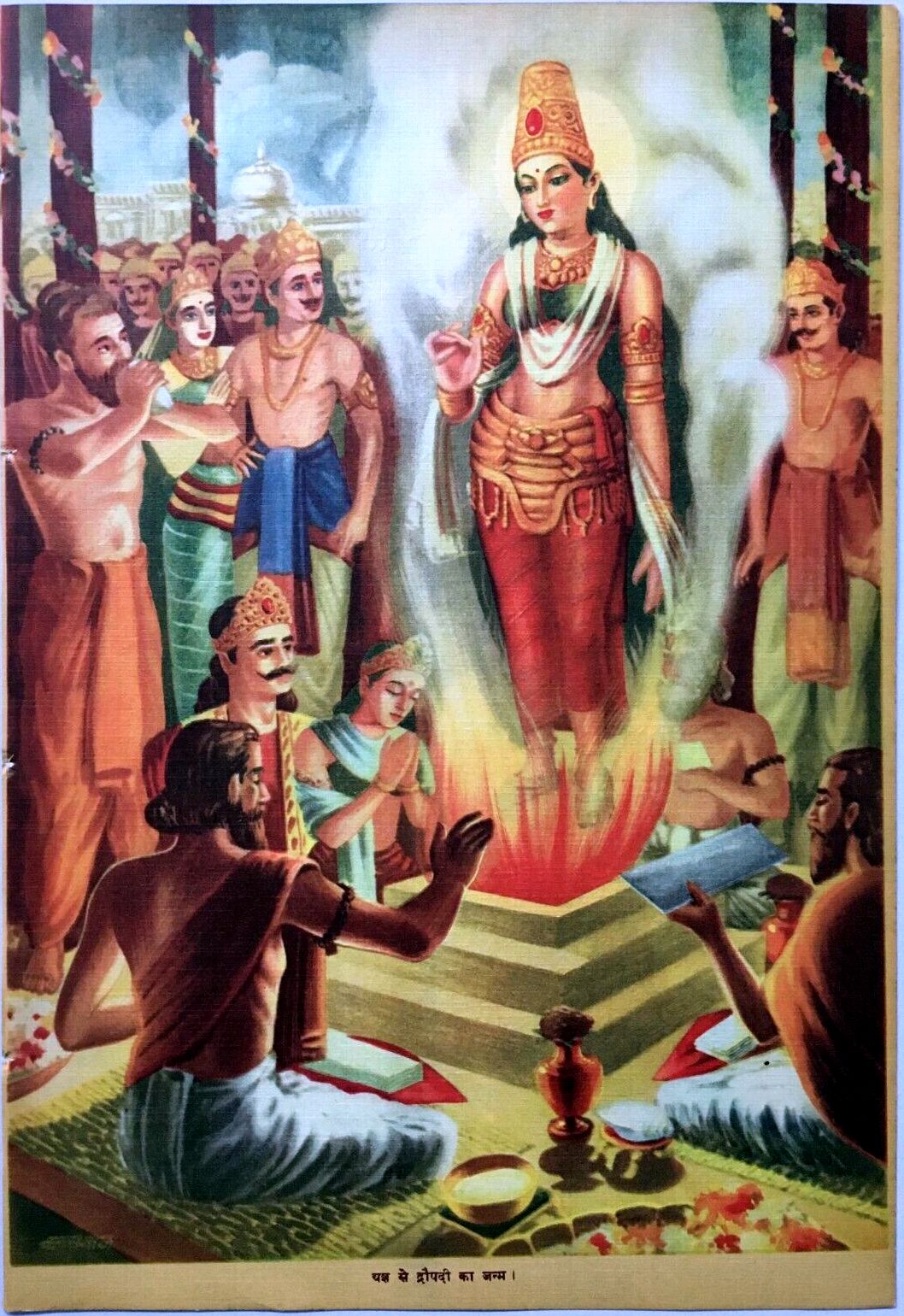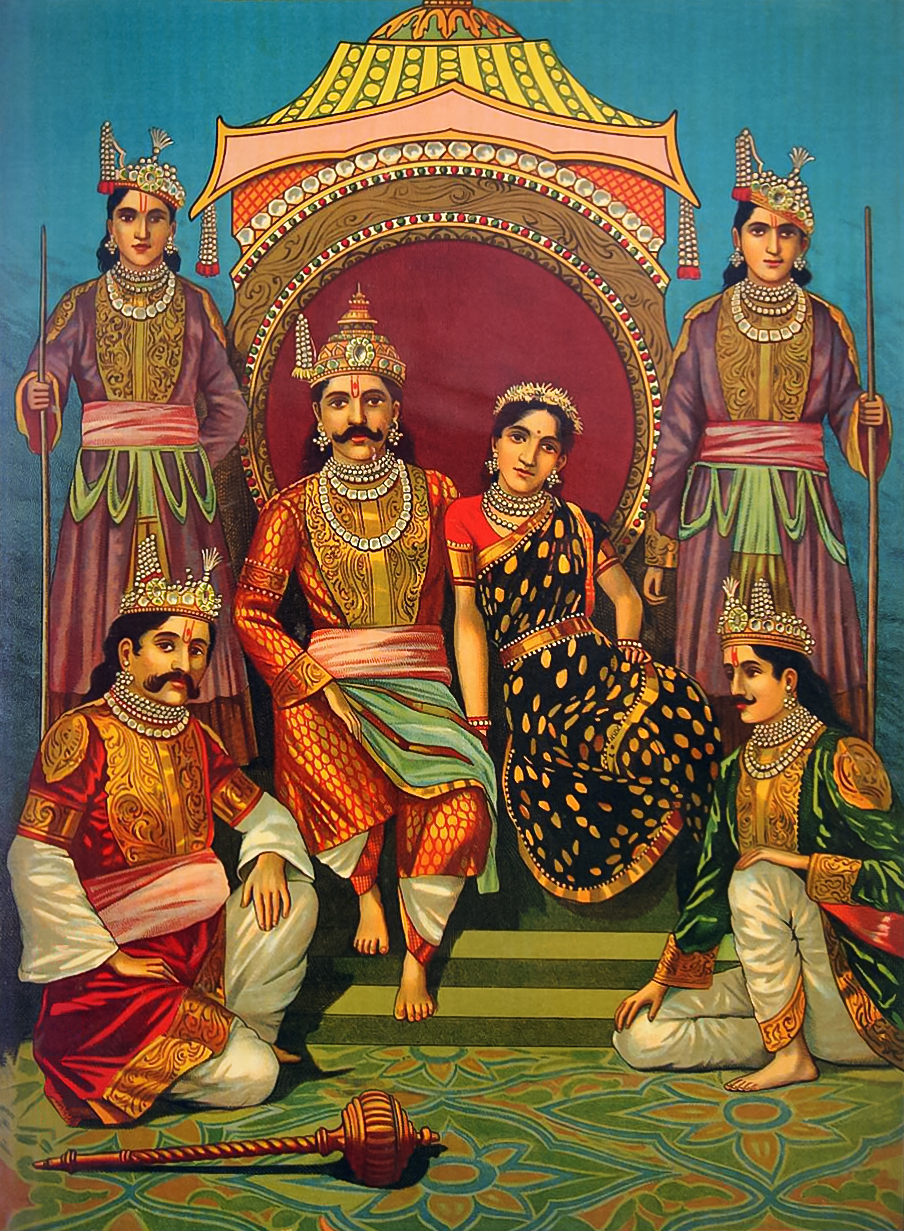|
Harivaṃśapurāṇa
was composed by Acharya Jinasena I in 783 AD. It is divided into 66 cantos and contains 12,000 slokas. The book aims to narrate the life of Neminatha, the twenty-second Tirthankara in Jainism. According to the Jain sources, Krishna was the first cousin of Tirthankara Neminatha. Therefore, Krishna's adventures too occupy a significant portion of the book. Harivaṃśa Purāṇa suggests that Draupadi was married to only Arjuna, as opposed to Hindu traditional accounts which suggests that she was married to all the five Pandavas. Synopsis In general, all Jaina Harivamśa narratives go far beyond what one might consider to be fitting for the ''Harivamśa'', i.e. the story of Krishna and his relatives, or Mahabharata material. They consist of four larger parts: (1) ''Harivamśa'', including the story of Krishna, his ancestors and progeny; (2) ''Nemicarita'', the biography of the 22nd Tīrthankara, Krishna’s cousin; (3) ''Pāndavacarita'', containing the central narrative of t ... [...More Info...] [...Related Items...] OR: [Wikipedia] [Google] [Baidu] |
Harivaṃśa
The ''Harivamsa'' (, ) is an important work of Sanskrit literature, containing 16,374 shlokas, mostly in the ''anustubh'' Metre (poetry), metre. The text is also known as the ''Harivamsa Purana.'' This text is believed to be a ''khila'' (appendix or supplement) to the ''Mahabharata''The Mahabharata in Sanskrit: Book I: Chapter 2 in sacred-texts.com website, (MBh.1.2.69): "hari vaṃśas tataḥ parva purāṇaṃ khila saṃjñitam bhaviṣyat parva cāpy uktaṃ khileṣv evādbhutaṃ mahat." ["Hari Vamsa Purana known as Khila (supplement) and Bhavishya Parva also spoken as Khila are wonderful and great"]. and is traditionally ascribed to Veda Vyasa, Vyasa. The most celebrated commentary of the ''Mahabharata'' by Neelakantha Chaturdhara, the ''Bharata Bhava Deepa'' also covers the ''Harivam ... [...More Info...] [...Related Items...] OR: [Wikipedia] [Google] [Baidu] |
Neminatha
Neminātha (Devanagari: नेमिनाथ) (Sanskrit: नेमिनाथः), also known as Nemi and Ariṣṭanemi (Devanagari: अरिष्टनेमि), is the twenty-second tirthankara of Jainism in the present age (). Neminath lived 84,000 years before the 23rd ''Tirthankar'' Parshvanath. According to traditional accounts, he was born to King Samudravijaya and Queen Shivadevi of the Yadu dynasty in the north Indian city of Sauripura. His birth date was the fifth day of ''Shravan Shukla'' of the Jain calendar. Balarama and Krishna, who were the 9th and last Baladeva and Vasudeva respectively, were his first cousins. Neminatha, when heard the cries of animals being killed for his marriage feast, freed the animals and renounced his worldly life and became a Jain ascetic. The representatives of this event are popular in Jain art. He had attained ''moksha'' on Girnar Hills near Junagadh, and became a siddha, a liberated soul which has destroyed all of its ka ... [...More Info...] [...Related Items...] OR: [Wikipedia] [Google] [Baidu] |
Jain Texts
Jain literature () refers to the literature of the Jainism, Jain religion. It is a vast and ancient literary tradition, which was initially transmitted orally. The oldest surviving material is contained in the canonical ''Jain Agamas'', which are written in Ardhamagadhi Prakrit, Ardhamagadhi, a Prakrit (Middle Indo-Aryan languages, Middle-Indo Aryan) language. Various commentaries were written on these canonical texts by later Jain monasticism, Jain monks. Later works were also written in other languages, like Sanskrit and Maharashtri Prakrit. Jain literature is primarily divided between the canons of the ''Digambara'' and ''Śvētāmbara'' orders. These two main sects of Jainism do not always agree on which texts should be considered authoritative. More recent Jain literature has also been written in other languages, like Marathi language, Marathi, Tamil language, Tamil, Rajasthani language, Rajasthani, Dhundari language, Dhundari, Marwari language, Marwari, Hindi language, ... [...More Info...] [...Related Items...] OR: [Wikipedia] [Google] [Baidu] |
Jainism
Jainism ( ), also known as Jain Dharma, is an Indian religions, Indian religion whose three main pillars are nonviolence (), asceticism (), and a rejection of all simplistic and one-sided views of truth and reality (). Jainism traces its spiritual ideas and history through the succession of twenty-four , supreme preachers of ''dharma''. The first in the current time cycle is Rishabhadeva, who tradition holds lived millions of years ago; the 23rd is Parshvanatha, traditionally dated to the 9th century Common Era, BCE; and the 24th is Mahāvīra, Mahavira, who lived . Jainism is considered an eternal ''dharma'' with the guiding every time cycle of the Jain cosmology, cosmology. Central to understanding Jain philosophy is the concept of ''bhedavijñāna'', or the clear distinction in the nature of the soul and non-soul entities. This principle underscores the innate purity and potential for liberation within every Jīva (Jainism), soul, distinct from the physical and menta ... [...More Info...] [...Related Items...] OR: [Wikipedia] [Google] [Baidu] |
Sanskrit
Sanskrit (; stem form ; nominal singular , ,) is a classical language belonging to the Indo-Aryan languages, Indo-Aryan branch of the Indo-European languages. It arose in northwest South Asia after its predecessor languages had Trans-cultural diffusion, diffused there from the northwest in the late Bronze Age#South Asia, Bronze Age. Sanskrit is the sacred language of Hinduism, the language of classical Hindu philosophy, and of historical texts of Buddhism and Jainism. It was a lingua franca, link language in ancient and medieval South Asia, and upon transmission of Hindu and Buddhist culture to Southeast Asia, East Asia and Central Asia in the early medieval era, it became a language of religion and high culture, and of the political elites in some of these regions. As a result, Sanskrit had a lasting effect on the languages of South Asia, Southeast Asia and East Asia, especially in their formal and learned vocabularies. Sanskrit generally connotes several Indo-Aryan languages# ... [...More Info...] [...Related Items...] OR: [Wikipedia] [Google] [Baidu] |
Tirthankara
In Jainism, a ''Tirthankara'' (; ) is a saviour and supreme preacher of the ''Dharma (Jainism), dharma'' (righteous path). The word ''tirthankara'' signifies the founder of a ''Tirtha (Jainism), tirtha'', a fordable passage across ''Saṃsāra (Jainism), saṃsāra'', the sea of interminable birth and death. According to Jains, ''tirthankaras'' are the supreme preachers of ''dharma'', who have conquered ''saṃsāra'' on their own and made a path for others to follow. After understanding the true nature of the self or soul, the ''Tīrthaṅkara'' attains ''kevala jnana'' (omniscience). A Tirthankara provides a bridge for others to follow them from ''saṃsāra'' to ''moksha'' (liberation). In Jain cosmology, the wheel of time is divided into two halves, Utsarpiṇī', the ascending time cycle, and ''avasarpiṇī'', the descending time cycle (said to be current now). In each half of the cycle, exactly 24 ''tirthankaras'' grace this part of the universe. There have been infini ... [...More Info...] [...Related Items...] OR: [Wikipedia] [Google] [Baidu] |
Krishna
Krishna (; Sanskrit language, Sanskrit: कृष्ण, ) is a major deity in Hinduism. He is worshipped as the eighth avatar of Vishnu and also as the Supreme God (Hinduism), Supreme God in his own right. He is the god of protection, compassion, tenderness, and love; and is widely revered among Hindu divinities. Krishna's birthday is celebrated every year by Hindus on Krishna Janmashtami according to the lunisolar calendar, lunisolar Hindu calendar, which falls in late August or early September of the Gregorian calendar. The anecdotes and narratives of Krishna's life are generally titled as ''Krishna Līlā''. He is a central figure in the ''Mahabharata'', the ''Bhagavata Purana'', the ''Brahma Vaivarta Purana,'' and the ''Bhagavad Gita'', and is mentioned in many Hindu philosophy, Hindu philosophical, Hindu theology, theological, and Hindu mythology, mythological texts. They portray him in various perspectives: as a god-child, a prankster, a model lover, a divine hero, ... [...More Info...] [...Related Items...] OR: [Wikipedia] [Google] [Baidu] |
Draupadi
Draupadi (), also referred to as Krishnā, Panchali and Yajnaseni, is the central heroine of the Indian epic poetry, ancient Indian epic ''Mahabharata''. In the epic, she is the princess of Panchala Kingdom, who later becomes the empress of Kuru kingdom, Kuru Kingdom. She is the Polyandry, common wife of the five Pandava brothers—Yudhishthira, Bhima, Arjuna, Nakula, and Sahadeva—and is renowned for her beauty, courage, devotion, intelligence and rhetorical skills. She is also described as ''sakhi''—a close friend—of the god Krishna. Draupadi, along with her twin brother Dhrishtadyumna, emerges fully grown from a ''yajna'' (fire sacrifice) organized by King Drupada of Panchala. Draupadi’s marriage is determined through a ''svayamvara'' (self-choice ceremony), structured as an archery contest of great difficulty. Arjuna succeeds in the challenge and wins her hand. However, their mother, Kunti, unknowingly instructs her sons to share whatever they had brought home, resu ... [...More Info...] [...Related Items...] OR: [Wikipedia] [Google] [Baidu] |
Arjuna
Arjuna (, , Help:IPA/Sanskrit, [ɐɾd͡ʒun̪ə]) is one of the central characters of the ancient Hindu epic ''Mahabharata''. He is the third of the five Pandava brothers, and is widely regarded as the most important and renowned among them. He is the son of Indra, the king of the Deva (Hinduism), gods, and Kunti, wife of King Pandu of Kuru kingdom, Kuru dynasty—making him a Demigod, divine-born hero. Arjuna is famed for his extraordinary prowess in archery and mastery over Astra (weapon), celestial weapons. Throughout the epic, Arjuna sustains a close friendship with his maternal cousin, Krishna, who serves as his spiritual guide. Arjuna is celebrated for numerous heroic exploits throughout the epic. From childhood, he emerges as an excellent pupil, studying under the warrior-sage Drona. In his youth, Arjuna wins the hand of Draupadi, the princess of the Pañcāla, Panchalas, by excelling in a formidable archery competition. Soon after, he goes on a journey during a period ... [...More Info...] [...Related Items...] OR: [Wikipedia] [Google] [Baidu] |
Pandavas
The Pandavas (Sanskrit: पाण्डव, aɳɖɐʋᵊ IAST: Pāṇḍava) is a group name referring to the five legendary brothers, Yudhishtira, Bhima, Arjuna, Nakula, and Sahadeva, who are central figures of the Hindu epic ''Mahabharata''. They are acknowledged as the sons of Pandu, the King of Kuru, but were fathered by different '' Devas'' (gods) due to Pandu's cursed inability to naturally sire children. In the epic, the Pandavas married Draupadi, the princess of Panchala, and founded the city of Indraprastha after the Kuru Kingdom was split to avoid succession disputes. After the split, the other part of the kingdom was ruled by their cousins, the Kauravas. However, the Pandavas lost their kingdom to Duryodhana (eldest and king of the Kauravas) when Yudhishthira gambled it away during a game of dice. The bet Yudhishtira agreed to was that the Pandavas would hand the kingdom over to the Kauravas and go into exile for 12 followed by an year in hiding. After this ... [...More Info...] [...Related Items...] OR: [Wikipedia] [Google] [Baidu] |
Vasudeva-hindi
''Vasudeva-hindi'' (IAST: Vasudevahiṇḍī, "Vasudeva's wanderings") is a Jain text by Sangha-dasa, probably from 5th century India. The text narrates several stories in the form of nested narrative layers. The main story is borrowed from Gunadhya's '' Brihat-katha'', with the original hero Nara-vahana-datta replaced by Krishna's father Vasudeva. Authorship and date ''Vasudeva-hindi'' is the oldest surviving text of the Jain narrative literature. The Jain monk Sangha-dasa wrote it in archaic Maharashtri Prakrit language. The author claims that the legend of Vasudeva was first told by Mahavira's pupil Sudharman to his disciple Jambu, and since then, the story was transmitted to the author through a series of teachers and disciples. The text was definitely composed before 610 CE, when Jina-bhadra-gani Kshama-shramana refers to it in his ''Visheshana Vati''. The author dates the text to the year 530 of an unspecified calendar era. Scholars K.R. Chandra and M.A. Dhaky believe ... [...More Info...] [...Related Items...] OR: [Wikipedia] [Google] [Baidu] |
Balarama
Balarama (, ) is a Hindu god, and the elder brother of Krishna. He is particularly significant in the Jagannath tradition, as one of the triad deities. He is also known as Haladhara, Halayudha, Baladeva, Balabhadra, and Sankarshana. The first two epithets associate him with ''hala'' (''langala'', "plough") from his strong associations with farming and farmers, as the deity who used farm equipment as weapons when needed, and the next two refer to his strength. Originally an agricultural deity, Balarama is mostly described as an incarnation of Shesha, the serpent associated with the deity Vishnu while some Vaishnava traditions regard him as the eighth avatar of Vishnu, with Jayadeva’s Gita Govinda (c.1200) "incorporat ngBalarama into the pantheon" as the ninth of the 10 principal avatars of Vishnu. Balarama's significance in Indian culture has ancient roots. His image in artwork is dated to around the start of the common era, and in coins dated to the second-century BCE ... [...More Info...] [...Related Items...] OR: [Wikipedia] [Google] [Baidu] |







